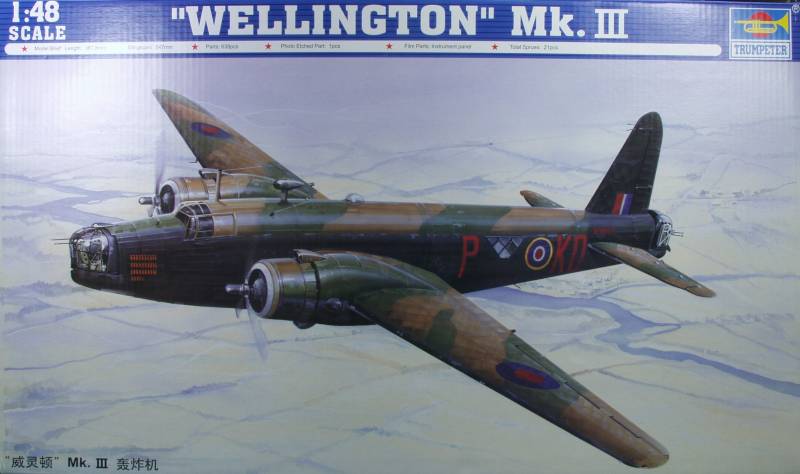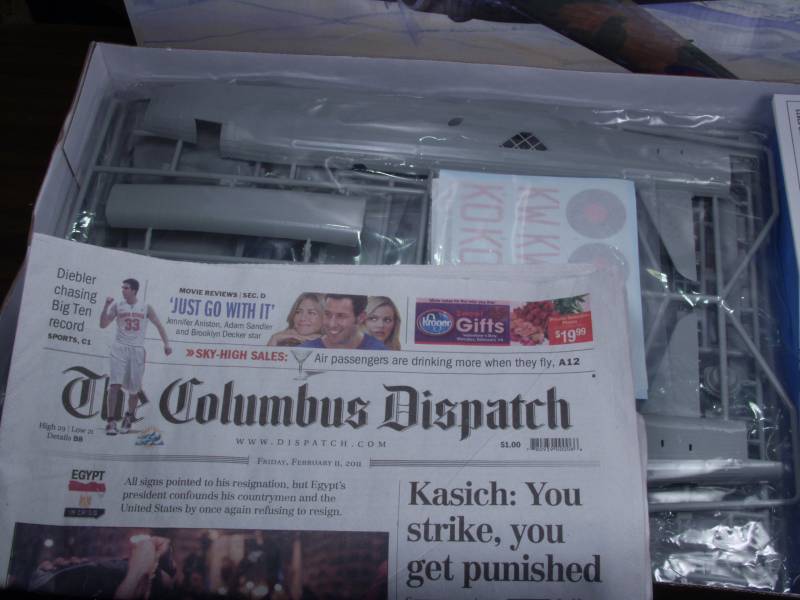Before I start on the build a few words about the kit itself. If you are interested in what comes in the box, rather than waste a lot of bandwidth here, you can read my inbox review of this kit on my website at
http://www.olddogsplanes.com/wellington.html.
The Trumpeter kit has been on the market for several years now, first as the Mk IC and shortly thereafter the Mk III. To the best of my knowledge, and I’ll admit I’m hardly an expert on the Wellington, there are no major accuracy issues which have been reported with the kit and that seems to be somewhat of a rarity for Trumpeter kits.
If there is any controversy surrounding the kit it deals with the treatment of the surface detail, specifically the under lying geodesic construction. Early on some of the reviewers felt that the surface detail was over done. At this point that is all I’m going to say about that.
It is my belief that this kit was not a big seller for Trumpeter. I have no proof to back this up but the fact that over the past couple of years it has shown up on sale at major retailers deeply discounted leads me to that conclusion. Whether the price was the issue, the discouraging early comments about the surface detail or the fact that it is a large model kept it from selling better I can’t say. I found the MSRP to be too high as are many of their kits but I picked mine up on sale for 60% off list and at that price it seemed to be a reasonable value for the money.
As far as the build is concerned here are some of the choices I have made so far;
1.) I am not a diorama builder or a vignette builder and for the most part prefer to build kits with no open panels and the like so the first decision I made was to leave the bomb bay closed. This reduces the workload and parts count considerably as Trumpeter supplies 3 sprues of ordinance containing 276 parts plus 10 others scattered about on other sprues and this also eliminates using the 30 bomb bay doors. This reduces the kits part count from 639 down to a more reasonable 323 parts in one fell swoop. While having the bomb bay open may seem like a good idea, I feel with a model of this size, picking it up to view it would result in more risk of damage than its worth.
2.) About the only other parts options involve the props, which are dependent on marking choices, cowling flaps opened or closed and different fuel dump pipes depending on whether one chooses to have the flaps up or down. In my case it will be flaps up.
Trumpeter supplies markings for two Wellingtons, both in standard schemes and my main issue with them are the colors as the red seems too bright for wartime usage. I have not found any aftermarket decals for the Mk III variant, there was one sheet released for the Mk I variant which also leads me to believe the kit did not sell well. I have a variety of decal sheets on the way, mostly lettering and fin flashes. The national markings could be painted on but I always seem to struggle getting the colors concentric with each other and I want to wait for my reference book to show up before deciding on markings. At this point it will not hold up the build.
3.) Trumpeter supplies a fair amount of internal detail, which in some ways is a shame as most of it will not be visible once the fuselage is closed up. There is also a whole list of other internal details available from after market suppliers, which can take this already pricey kit into the stratosphere if you are so inclined. The MK III has even fewer windowed areas that the MK I so again most of what goes inside will not be seen. I managed to restrain myself to an Eduard’s Zoom set for the cockpit which supplies primarily the instrument panel and some other black boxes and details and a seat belt set as neither Eduard’s Zoom set or the PE that comes with the kit contain them. I also obtained a mask set since masking is not one of my favorite activities and will most likely replace the machine gun barrels with resin or metal versions.
While it would be easy enough to just ignore the interior parts that won’t be visible, that is one area where I tend to be a glutton for punishment and most likely will install most of it. Even if no one can see it I know it’s there and will have photos to back it up.
OK, with that out of the way, I’ll cover my strategy for assembly. For a kit of this complexity I like to clear out any parts I know I’m not going to use for what ever reason to make room in the box and eliminate the possibility that I might try to use or paint up by mistake a part that I don’t need. In this case, four full sprues come right out and go to the surplus parts box. I should have enough British ordinance to last me a long time ! The other dozen or so other parts that I know for certain will not be used will be removed as well. With all of those removed the remaining parts looked a lot more manageable.
Assembly will start with the interior but I like to build other sub assemblies during times when I’m waiting for paint or glue to dry such as engines, wing and horizontal tail surfaces and paint up anything that can be in advance to allow them to cure fully before they need to be used.
One of the most interesting challenges with this kit is the color for the interior of the fuselage walls. The framework was covered with linen then given a coat of red dope on the outside. What you see on the inside is what soaks through the linen and of course this is not a uniform color but blotchy depending on how heavily and uniform it was applied on the outside. Color photos of this I have found on line show a color similar to that of Bondo spot putty with a hint of the linen color. I may be seeking help from you WW I modelers on achieving this effect. To add to the difficulty the framework itself was left natural aluminum. I have some ideas on doing this but am not sure how well it will work. Worse case scenario I can always abort and seal it up with no one being the wiser. The most visible area, the cockpit and nose area were painted black.
Sorry if I got a bit windy, I promise once things are started there will be more photos and less verbiage.






















